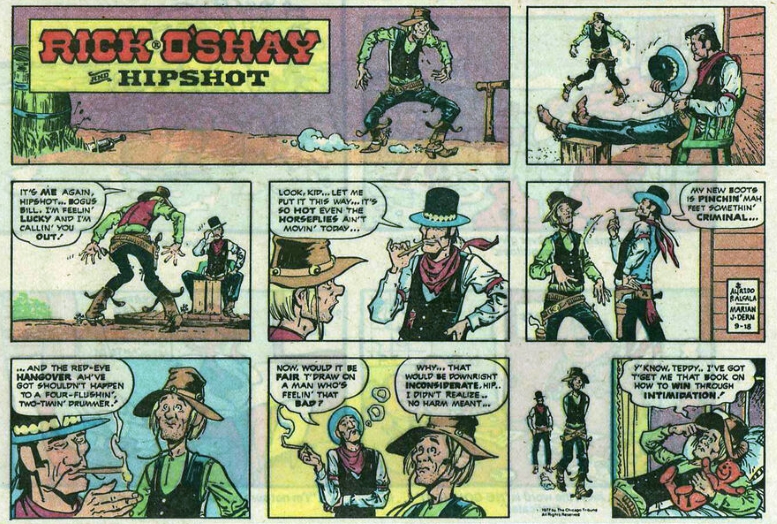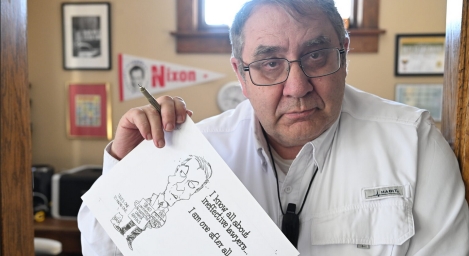’25 Eisner Hall of Fame Nominees – Their Comic Strip Credentials
Skip to commentsEarlier The Will Eisner Awards Hall of Fame judges named their inductees for automatic inclusion into the 2025 Hall of Fame. They have now released the names of 18 nominees for fans to vote on for inclusion.
The Eisner Awards Hall of Fame judges have chosen 18 nominees from whom voters will select 6 to be inducted into the Hall of Fame this summer. These 6 will be joining the 21 individuals that the judges have already chosen for the Hall of Fame.
The 18 nominees are Alfredo Alcala, Kyle Baker, Bob Bolling, Eddie Campbell, Roz Chast, Dan Clowes, Mark Evanier, Mike Friedrich, Don Heck, Junji Ito, Ben Katchor, Todd Klein, Peter Kuper, Lee Marrs, John Romita Jr., Posy Simmonds, Leonard Starr, and Rick Veitch.
As with our review of the inductees comic strip credentials some of the nominees were eligible last year and we refer to that post for background on Don Heck and Leonard Starr.
On to the fresh nominees and the newspaper comics they worked on.
Alfredo Alcala (1925–2000)
Alfredo Alcala began his comics career in 1948 in the Philippines and became a popular artist in that country with the release of his creator-owned property Voltar in 1963. The acclaim in his home country led him to the American comics industry, where in the early 1970s he began a career that would see him work steadily for very nearly the next 30 years. At Marvel Comics he contributed to many issues of Savage Sword of Conan, and he provided artwork for a number of issues of Creepy and Eerie magazines for Warren Publishing. DC Comics showcased Alcala’s talents in the early 1970s in its horror and war comics; he later moved on to titles such as All-Star Squadron, Detective Comics, and most notably Swamp Thing, where his graceful, moody inks helped maintain that book’s style through various art and editorial changes.
Alcala had quite a comic strip career from the late 1970s to the early 1980s.




Alfredo Alcala drew the Rick O’Shay comic strip from July 1977 (Stan Lynde) to January 1978 (Mel Keefer); He followed Ernie Chan on Conan The Barbarian for a few months in 1978 from June to October; and then when Russ Manning could no longer continue on the Star Wars comic strip Alfredo was drafted to fill in (August 1980 to February 1981) until Al Williamson was free to take up the art chores. A couple years later he spent a week May 30 – June 4, 1983) subbing for Ernie Colon on the art for the Star Trek comic strip.
Kyle Baker (1965– )
Kyle Baker has authored more than 15 graphic novels and illustrated hundreds more in a career that extends over three decades. He is the winner of eight Eisner Awards and four Harvey Awards, among others. A pioneer in the graphic novel format since the 1980s, Baker helped define and evolve the medium with works such as Nat Turner, Why I Hate Saturn, and King David. Other titles include The Cowboy Wally Show; Truth: Red, White & Black; and Birth of a Nation.

The much admired cartoonist Kyle Baker spent Summer and Fall of 1998 drawing a comic strip – surprisingly it was The Rugrats comic strip. Anime Express indexed the creators of The Rugrats comic strip, below are the Kyle Baker credits.
7/5/98 (Anon; probably G/Ba))
7/6-11/98 (G/Ba)
7/12/98 (Anon; probably G/Ba))
7/13-18/98 (G/Ba)
7/19/98 (G/Ba)
7/20-25/98 (G/Ba)
7/26/98 (G/Ba)
8/2/98 (G/Ba)
8/9/98 (G/Ba)
8/16/98 (G/Ba)
8/23/98 (G/Ba)
8/24-29/98 (G/Ba)
8/30/98 (G/Ba)
9/6/98 (G/Ba)
9/13/98 (G/Ba) Cynthia tells Angelica to get cookies.
9/20/98 (G/Ba) The infamous synogogue strip. For details, click here.
10/4/98 (G/Ba)
10/12-17/98 (G/Ba)
10/18/98 (G/Ba)
10/25/98 (G/Ba)
11/1/98 (G/Ba)
11/8/98 (Anon, possibly G/Ba)
Bob Bolling (1928– )
Robert (Bob) Bolling became a freelancer at Archie Comics in 1954, where his first work was writing and drawing joke pages and the “Pat the Brat” feature. In 1956 he created the Little Archie comic, starring younger versions of the classic Archie characters. He worked on the comic full time until 1965, then moved over to other titles, including Archie, Archie’s Pals and Gals, Archie and Me, and Sabrina the Teenage Witch. He has continued to draw comic stories for Archie Comics digests until he was well into his 80s.
The beloved creator/writer/artist of Little Archie had worked on comic strips before joining the Archie Comics group. Bob Bolling‘s newspaper comic career was as an art assistant to cartoonist George Shedd when Shedd was assisting on Al Capp’s Li’l Abner in 1952 (yes, Bob was an art assistant to an art assistant).

When George Shedd decided to try his hand on his own Marlin Keel comic strip Bob followed.
Mark Evanier (1952– )
Mark Evanier attended his first San Diego Comic-Con in 1970 and has been to every one of these annual events ever since. He was then an assistant to the great Jack Kirby, whom he wrote about in his book Kirby, King of Comics. His comics include writing such titles as DNAgents, Crossfire, and Blackhawk along with working with Sergio Aragonés for 40 years on Groo the Wanderer, and many more. He is also a historian of comic books and animation with many books to his credit.
If I am remembering correctly Mark Evanier has admitted working on a comic strip though he has never divulged which one, but definitely not Garfield! Mark’s entry at Jerry Bails’ Who’s Who shows him working on a number of comic characters’ comic books and animation who at the same time were in newspaper comic strips.
Ben Katchor (1951– )
Ben Katchor’s picture-stories—including Julius Knipl, Real Estate Photographer; The Jew of New York; The Cardboard Valise; Hotel and Farm, and Shoehorn Technique—have been appearing in newspapers and magazines around the country since 1986. He has taught and lectured extensively throughout the U.S. and Europe. Six collections of his strips have been published: Cheap Novelties, The Pleasures of Urban Decay; Julius Knipl, Real Estate Photographer; The Jew of New York; The Beauty Supply District; The Cardboard Valise; and Hand-Drying in America and other stories.

Ben Katchor‘s first claim to fame was his Julius Knipl, Real Estate Photographer comic strip for alternative newspapers from 1988 to 1998.
Edited to add:
Peter Kuper (1958– )
Peter Kuper has been a regular contributor to The New Yorker, The Nation, and MAD magazine where he wrote and drew “SPY vs. SPY” every issue from 1997 to 2022. His “Eye of the Beholder” was the first comic strip to ever regularly appear in the New York Times. He is the co-founder and editor of World War 3 Illustrated, a political graphics magazine that has given a forum to political artists for over 40 years. He has produced over two dozen books, including The System, Diario de Oaxaca, Ruins (winner of a 2016 Eisner Award), and adaptations of many of Franz Kafka’s works into comics, including The Metamorphosis and Kafkaesque (winner of the 2018 Reuben Award). His latest graphic novel is an adaptation of Joseph Conrad’s Heart of Darkness.

Started as the first comic strip ever to run in the New York Times, this silent set of strips chronicles the world, its foibles, its intricacies, its dreams through the eyes of most anything you can imagine. The trick is to figure out whose eyes they are before seeing the final panel…
Now back to our regularly scheduled program.
Lee Marrs (1945– )
Best known for The Further Fattening Adventures of Pudge, Girl Blimp, Lee Marrs was a frequent contributor to underground comics and one of the “founding mommies” of the Wimmen’s Comix collective, as well as Gay Comics. As one of Mike Friedrich’s Star*Reach regulars, she expanded her writing and art style to include serious fantasy fiction in “Stark’s Quest” (1977–1979). Marrs had a mainstream comics career at the same time. After assisting on Prince Valiant, Lil’ Orphan Annie, and other comic strips, she drew tales for DC’s Plop, Weird Mystery, and House of Secrets. But most of her mainstream comics work was as a writer, for Unicorn Isle (1983), Wonder Woman: Annual (1989), Viking Glory: the Viking Prince (1991), Zatanna: Come Together (1993), Faultlines (1997), and Batman: Legends of the Dark Knight: Stalking (1998). She also wrote Dark Horse’s series Indiana Jones and the Arms of Gold (1994) and Indiana Jones and the Iron Phoenix (1995).

Lee Mars is known to have assisted Tex Blaisdell with the art on Little Orphan Annie during the 1969-74 years.
John Romita Jr. (1956– )
John Romita Jr.’s first contribution to Marvel Comics was at the age of 13 with the creation of the Prowler in Amazing Spider-Man #78 (1969). He began his career at Marvel UK, doing sketches for covers of reprints. His American debut was with a story in Amazing Spider-Man Annual (1977). He went on to popular runs on Iron Man, Amazing Spider-Man, Uncanny X-Men, Daredevil, The Punisher War Zone, Cable, Daredevil: The Man Without Fear, Thor, Kick-Ass, Superman, and All-Star Batman, just to name a few.

The not-always-reliable Heritage Auctions claims “Senior allegedly let Junior practice on the strip with the layouts and some background inking.” “Romita Sr. and Romita Jr. have signed the strip in the bottom margin.”
Posy Simmonds (1945– )
British cartoonist Rosemary Elizabeth “Posy” Simmonds has managed to make her mark in the graphic novel publishing world by reinventing classic literature into illustrated novels for adults. She is best known for her long association with London’s The Guardian, where she serialized Gemma Bovery (2000) and Tamara Drewe (2005–2006) before their publication in book form. In 1987, she began to write and illustrate children’s books, creating such works as Lulu and the Flying Babies (1988) and Fred (1987), the film version of which was nominated for an Oscar. She was made a Member of the British Empire in 2002 for her services to the newspaper industry, and she received the Grand Prix de la ville d’Angoulême in 2024.

Paul Hudson lists Posy’s British comic strips, from 1969 to 2005, as Bear; The Silent Three of St. Botolph’s; Gemma Bovary; Literary Life; and Tamara Drew.


Comments 4
Comments are closed.